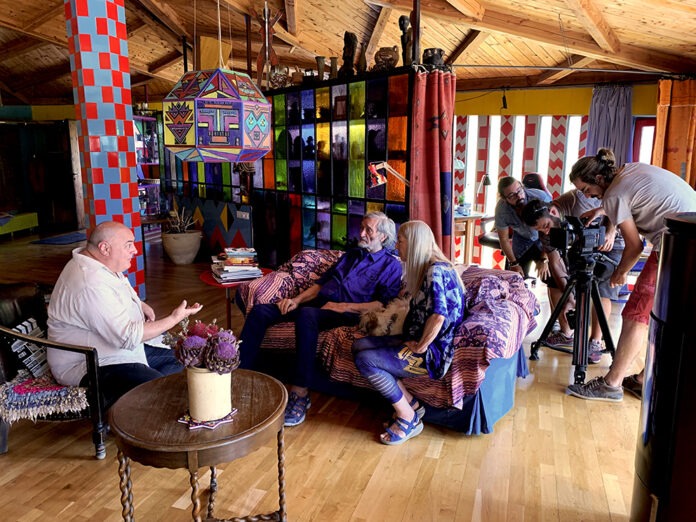At the turn of the 60s and 70s the artist Nick Spatari he ventured out with his wife, the Dutch collector and photographer Hiske Maasin the lands of Aspromonte where he was born giving life to the heroic enterprise of the construction of Musaba. The laboratory museum has become a beacon for many artists. Spatari was a huge, revolutionary artist capable of capturing light like few others and giving the works bright colors, like a Calabrian Van Gogh. His life and his works are the subject of the documentary film “Jacob’s dream” directed by Luigi Simone Veneziano and produced by the cultural association The Six Sisters. The story of the famous artist’s life that mixes archival material and fiction, was premiered at Citrigno cinema in Cosenza.
In the documentary film it is possible to scexplore a myriad of nuances of the man and artist Nik Spatari. But who was he really?
A visionary, an artist of extreme sensitivity. He lacked an important sense, hearing which he lost as a young man. He started because of a genetic issue and the bombings of the Second World War accentuated it. My film opens in black and white with him losing his hearing as a child and from that moment everything takes color. Nik was an exceptional person who despite his deafness knew how to grasp the world in an excellent way, among other things he never had any problem in making himself understood wherever he went. He lived in France, in America, in Holland where he met the collector and photographer Hiske Maas who later became his wife. Furthermore, she had a passion for the use of light, which is why she decided to return to Aspromonte. Land bathed in a light that he had never been able to find in other places. At times he recalls Mexico between lunar landscapes and desolate lands, where the light reflects on the white boulders giving particular colors. Nik decided to go and live there in a dark period for Calabria and brought the light; he opened a window, transforming an old ruin into a place of art that over time has had numerous visitors. A laboratory where many international artists have lived and where they have been able to create their own works, obviously respecting Nik’s aesthetic canons.
Can you tell us about the moment in which Spatari became the most famous artist in France thanks to the “theft” of one of his works by Jean Cocteau?
He became the most famous artist thanks to a curious anecdote: Cocteau he stole one of his paintings as much as he admired it, from here began his artistic career as an adult. I use the word “adult” because Nik had already won the competition at “The Courier of the Littles” as best young Italian artist with one of his drawings on the Second World War.
Do you think the absence of hearing can make him comparable to Goya? Although there is an inverse process between the two to reach the completion of a work
I’m not an art critic, but knowing the art of both I can define them as two geniuses at the antipodes as one tries to grasp and praise the power of light and the other, instead, prefers the dark in its place. I believe that the process that led both to their artistic catharsis can be traced back to the missing element, hearing, so as to arouse a different interpretation of the world.
Could the Musaba be defined as the capital work of master Spatari, his temple?
I would define it more a prosthesis of his body. Now his body rests there, like a work of art and it is possible to visit it. This also tells us how much the Musaba was important to Nik and how personal it is, so much that he decided to be a part of it. It is a very intimate work despite being such a vast place.
Through the artist’s story one is kidnapped by a light, by a spirituality: a sort of return to the origin.
He certainly had a great spiritual and even religious vocation, but in an alternative way. For example, the large three-dimensional mosaic, the only one ever made, recounts numerous biblical episodes but in a modern language. In the Annunciation there is a bright spark in the Madonna’s womb and, observing the work, I asked Nik if that was the spirit of God and he replied that it was the Higgs bosontherefore the God particle. He had an ultra-modern vision despite his ninety years and in him faith and science were strongly united. Its strong spirituality is also felt when one has the opportunity to visit the splendid Musaba.
How did your journey into Nik Spatari’s human and artistic experience come about?
The meeting with Nik was dazzling. The construction of the film comes from a canvas which then underwent changes during filming because there was a continuous discovery of her world, her past, her incredible life. I found Super16 film inside an abandoned warehouse. The movies were all made by Nik and are amazing; they have a beautiful light. A journey between the present and the past, in which the allegorical figure of the child encloses his spirit, what he has always carried with him through his purity and which I hope is felt in the images. It all comes from there, from childhood.
“Jacob’s dream” the art of Nik Spatari in the doc by Luigi Simone Veneziano – Il Giornale OFF

